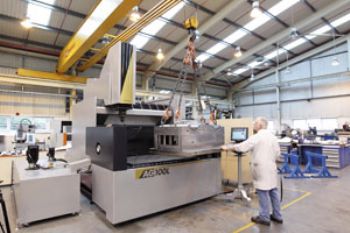
The first Sodick AG100L CNC die-sink EDM in Europe has been installed at the Sutton Coldfield premises of WH Smith and Sons (Tools) Ltd, where it is ‘sparking’ large tools such as automotive radiator grille cavities in about a week (100-150hr); previously, this could take four weeks, using smaller-capacity machines.
Talking of the machine supplied by Coventry-based Sodi-Tech EDM Ltd (www.sodi.techedm. co.uk), tool-room manager Stephen Hunt says: “In terms of pure speed, I would estimate that it’s around 30% faster than our existing machines. We can also accommodate a greater quantity of work — not just larger workpieces — by sparking several smaller jobs on the same table. Before, we would have required pallet-change technology to facilitate this configuration.
“Overall, the AG100L is making us more competitive. Features such as linear drives, which give high-speed movement of the head, along with deep-rib and deep-machining capability, provide a genuine market-place different-iation. It demonstrates that we are not scared of change here; we will invest in new technology if it improves our business. We know that if we make tools to the right quality, price and lead-time, customers will come to us.”
WHS is a diverse manufacturing company offering a complete injection moulding service, including product and tool design, tool making, injection moulding, painting and assembly. In recent years the 300-employee, £15 million-turnover company has expanded its tool-making operations, and today this part of the business is generating an annual turnover of around £3 million, with automotive contributing some 70% of this.
Single-source supply
Mr Hunt says: “Increasing numbers of automotive customers are coming to us for several reasons. For a start, customers prefer a single source for both parts and tooling; with us, they can also see the tools, which is not possible if using a resource in the Far East. Additionally, the ability to offer a quick response to modiifications is highly valued by customers.”
Mr Hunt says that the company’s tool-room, which has 20 staff, is as busy now as it has ever been, with continuous investment helping it to become one of the largest and most advanced in the UK plastics industry. “Even when the automotive sector suffered during the credit crunch of 2009, we didn’t stop investing,” he says. “I would say we have invested more in the past three years that at any time in our history, and it’s really paying dividends.”
Among the most recent arrivals at WHS is the new Sodick AG100L, installed in September 2011 following a spate of contract wins for larger tools. “We had recently been to an open day at Sodi-Tech, looking at new wire EDM and hole-burner technology, so when the requirement for a large die-sink EDM arrived, we knew who to contact,” says Mr Hunt.
The AG100L — Sodick’s newest CNC die-sink EDM — features linear-motor technology, as well as simplified control mechanisms that provide a direct link between the drive and control. This ensures the fastest possible servo response time and optimal spark gaps at all times. Moreover, the machine’s automatic, vertically sliding drop-door enables large workpieces to be easily loaded and unloaded.
WHS’s tool makers took readily to the AG100L. Indeed, in the 72hr after the three-day Sodick training course, they had completed some 65hr of successful sparking. Working every day since it was installed, the machine has been a huge success for WHS; thanks to its large work tank, workpieces up to 2m long and weighing up to 5 tonnes can be accommodated.
This capacity has helped the company in a number of ways, allowing it to meet the growing demand not only for large automotive injection mould tools (such as radiator grilles), but also for bumper support brackets, number-plate plinths and much more.
“The AG100L is not limited to large parts and large electrodes,” says Mr hunt. “It is also excellent for features such as thin ribs. Previous-ly such details would be a challenge, perhaps involving the manufacture of an insert, but this problem no longer exists. The greater capability of the machine gives us new freedom from a design perspective.”